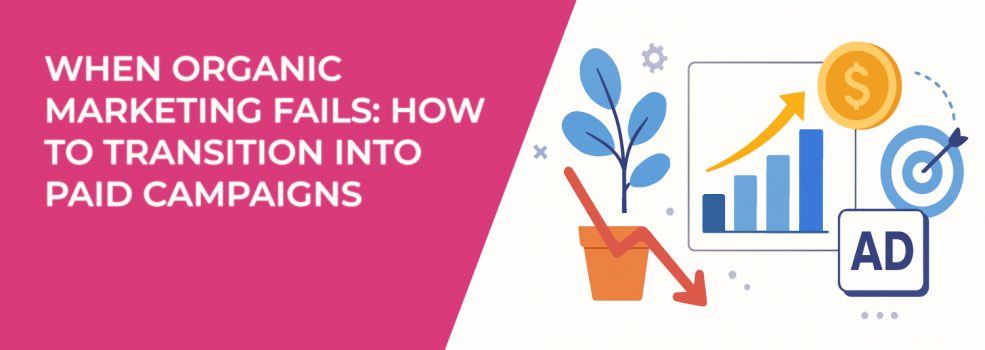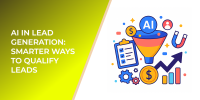You’ve been posting consistently with solid content and decent engagement, but suddenly the momentum slows, reach drops, and conversions stall.
If you’ve been relying solely on organic marketing, this moment will eventually come.
The good news? It’s not the end of your growth. It’s a signal: your strategy needs to evolve.
Moving from organic to paid doesn’t have to be risky. If done correctly, paid ads can accelerate what you've already built, scale your brand visibility, and generate steady ROI.
Here’s how to transition into paid campaigns without wasting your budget or losing the trust you built organically.
1. Understand Why Your Organic Reach Flatlined
Before jumping into Meta Ads Manager, pause. Organic marketing rarely fails without reason. To move forward, you need to understand what broke.
Ask yourself:
-
Has your audience shifted — demographically, behaviorally, or platform-wise?
-
Are your posts getting impressions but little engagement?
-
Are your followers growing while conversions stay flat?
Example: A small e-commerce brand had been posting behind-the-scenes videos and user-generated content. It worked well for a while — until their followers started expecting more professional product content and clearer offers. Their organic content didn’t evolve, and engagement plummeted.
Don’t just assume the algorithm is the villain. Often, it’s a misalignment between content and customer needs.
Actionable tip: Dig into analytics on Facebook and Instagram. Look for patterns in your top posts. Compare high-performing months to your current data. Then, read this audience-targeting guide to re-identify who you're trying to reach — and how to reach them with the right message.
2. Set Paid Campaign Goals That Tie to Outcomes — Not Just Reach
Paid ads aren't magic. They're tools. And like any tool, they’re only effective when you use them for the right job.
You need to define why you’re launching a paid campaign. Don’t just say, “I want more traffic.”
Do you want to:
-
Capture qualified leads through a lead magnet, form, or webinar?
-
Sell specific products and track revenue directly from the ad?
-
Re-engage past visitors who haven’t purchased?
-
Grow your email list with gated content?
Each goal maps to a specific Meta campaign objective. Picking the wrong one can sabotage your results.
Example: If you’re running a campaign to drive webinar signups, but you choose the “Traffic” objective instead of “Leads” or “Conversions,” Facebook will optimize for clicks, not form submissions. That can lead to high spend and little ROI.
Learn more about making the right selection with this full guide to Meta ad objectives.
3. Repurpose Your Organic Wins to Build High-Performing Paid Creatives
Your past organic content is a creative goldmine. Even if engagement has dipped, your top posts still hold valuable clues.
Ask:
-
Which videos or posts got the most saves, shares, or replies?
-
What types of visuals stopped the scroll?
-
What language or hook drew comments?
Example: A business coach had a 3-slide Instagram carousel breaking down the “3 biggest mistakes service providers make on sales calls.” It reached 10,000+ people organically. She repurposed it into a short video ad, used the same structure, and ran it to cold audiences. The result? A 2.7% CTR and $3.80 cost per lead.
To maximize results:
-
Edit your best-performing videos into shorter, snappier formats.
-
Turn helpful posts into carousel ads or Reels with stronger CTAs.
-
Use comment questions as copy for new ads.
If you’ve already tested creative ideas organically, you’re miles ahead. And if you're struggling to convert your content into ad format, don’t worry — this guide can help you fix underperforming creatives fast.
4. Target the Right People — Avoid the Boost Button Trap
Boosting posts is tempting. It’s easy. But it’s also inefficient.
Why? Because the Boost feature offers very limited targeting — and often sends your ad to people who will never buy from you.
To succeed with paid ads, you need intentional targeting. Use a layered approach:
-
Custom audiences — based on website visitors, people who watched your videos, engaged on Facebook, or signed up for your emails.
-
Lookalike audiences — modeled after your top buyers or email subscribers, allowing you to find new people who behave like your best customers.
-
Retargeting audiences — people who clicked an ad but didn’t buy, added to cart, or visited your sales page.
Example: A local service business ran cold ads using broad interests and saw zero leads. After shifting to custom audiences built from Instagram engagement and a 1% lookalike based on email subscribers, their CPL dropped from $28 to $6.30.
Running into issues where your ad set won't even launch? You might be seeing the “Ad Set May Get Zero” warning in Ads Manager. It’s more common than you think — and here’s exactly how to fix it.
5. Start Small, Test Intentionally — Then Scale with Confidence
You don’t need a huge budget to get started. In fact, starting small helps you learn without blowing cash.
Here’s a smart way to structure your early tests:
-
Launch 3–4 ad sets with different audiences (e.g., cold lookalikes, warm retargeting).
-
Use 2–3 creatives per ad set — like one testimonial video, one UGC-style image, and one carousel with a strong CTA.
-
Set daily budgets of $10–$20 per ad set and let the data run for at least 3–5 days before making decisions.
Example: A wellness brand tested three creatives: a calming video, a product benefits breakdown, and a founder story. The founder story — shot selfie-style — won by a landslide. They scaled that creative across audiences and doubled their ROAS.
Want help building smarter test structures? Start with Facebook Ad Targeting 101 to avoid costly mistakes.
6. Align Paid and Organic — Let Them Work Together
Paid ads shouldn’t replace your organic strategy. They should reinforce it.
Think of organic as the foundation. Paid campaigns are the amplifier.
Here’s how to merge them:
-
Promote your strongest organic content with paid reach — especially videos, carousels, or posts with lots of saves and shares.
-
Retarget people who’ve interacted with your organic content, guiding them deeper into your funnel.
-
Use your organic feed to build trust and warm up new ad-driven followers with consistent storytelling, proof, and value.
Example: A fitness coach ran a lead ad to drive opt-ins for a free challenge. After the signup, she tagged new subscribers and showed them a welcome video, followed by daily tips via organic Stories. The result? A 26% conversion rate from lead to paid client.
Your funnel should be fluid. Paid gets people in the door — organic helps them stay.
7. Track the Right Metrics — Stop Obsessing Over Reach
Not all data is useful. Many marketers get stuck chasing vanity metrics like reach, impressions, or post likes.
But those numbers don’t tell you if your ads are working.
Here’s what matters more:
-
Cost per lead (CPL) — are you acquiring contacts at a sustainable cost?
-
Click-through rate (CTR) — does your ad spark interest and action?
-
Landing page conversion rate — do your clicks turn into buyers or signups?
-
Return on ad spend (ROAS) — is your campaign generating more revenue than it costs?
Example: An agency noticed one campaign had a great CTR (3.4%) but a low conversion rate (3%). After reviewing the landing page, they realized it didn’t match the promise of the ad. A quick headline and layout update brought conversions to 10% — without touching the ads.
Struggling to pinpoint what’s broken? This post on fixing non-converting Facebook ads gives you a clear checklist for diagnosing every part of the funnel.
Final Thoughts
Organic reach alone isn’t built for scale. It’s slow, inconsistent, and unreliable — especially on platforms that reward paid visibility.
But your organic efforts weren’t wasted. They taught you what works. They built trust. They gave you a creative testing ground.
Now it’s time to take that foundation and amplify it with paid campaigns.
Start with strategy. Target smarter. Test methodically. And never stop optimizing.

